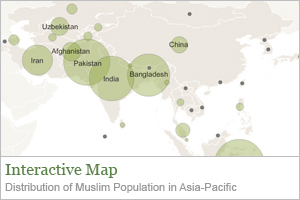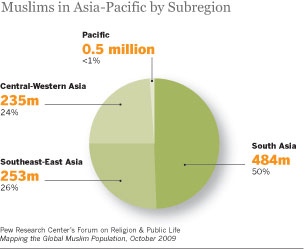
Muslims living in the Asia-Pacific region, which includes 61 countries and territories, constitute 62% of all Muslims worldwide.
The six Asian countries with the largest Muslim populations are: Indonesia (203 million), Pakistan (174 million), India (161 million), Bangladesh (145 million), Iran (74 million) and Turkey (74 million). Together these six countries are home to about 85% of Asia’s Muslim population and more than half (53%) of the global Muslim population.

About half of the Muslim population within Asia lives in South Asia (50%) and the remainder are somewhat equally divided between Southeast-East Asia (26%) and Central-Western Asia (24%). Very few Muslims, however, live in the Pacific (<1%).1
Indonesia is the country with the world’s largest Muslim population (203 million); about 13% of all Muslims in the world live in Indonesia. Indonesia’s Muslim population accounts for about 80% of all Muslims living in Southeast-East Asia.
In South Asia, three of the seven countries – Pakistan, India and Bangladesh – together are home to nearly a third (31%) of the world’s Muslim population and 99% of South Asia’s Muslim population.
Other Asian countries with more than 20 million Muslims include Afghanistan (28 million), Uzbekistan (26 million) and China (22 million). There are Muslims in every province of China, but the highest concentrations are in the west, primarily in Xinjiang, Ningxia and Gansu, with other significant populations in Henan, Qinghai, Yunnan, Hebei and Shandong. Xinjiang is the only Muslim-majority province of China, with Muslims accounting for approximately 53% of the total population.
Countries in Asia-Pacific with the Largest Number of Muslims
| Estimated 2009 Muslim Population | Percentage of Population that is Muslim | Percentage of World Muslim Population | |
|---|---|---|---|
| Indonesia | 202,867,000 | 88.2% | 12.9% |
| Pakistan | 174,082,000 | 96.3 | 11.1 |
| India | 160,945,000 | 13.4 | 10.3 |
| Bangladesh | 145,312,000 | 89.6 | 9.3 |
| Iran | 73,777,000 | 99.4 | 4.7 |
| Turkey* | 73,619,000 | ~98 | 4.7 |
| Afghanistan | 28,072,000 | 99.7 | 1.8 |
| Uzbekistan | 26,469,000 | 96.3 | 1.7 |
| China | 21,667,000 | 1.6 | 1.4 |
| Malaysia | 16,581,000 | 60.4 | 1.1 |
| Rest of Region | 49,148,000 | 7.1 | 3.1 |
| Regional Total | 972,537,000 | 24.1 | 61.9 |
| World Total | 1,571,198,000 | 22.9 | 100.0 |
| * Data for Turkey come primarily from general population surveys, which are less reliable than censuses or large-scale demographic and health surveys for estimating minority-majority ratios (see Methodology). As a result, the percentage of the population that is Muslim in Turkey is rounded to the nearest integer.Note: Figures may not sum to totals due to rounding.
Pew Research Center’s Forum on Religion & Public Life • Mapping the Global Muslim Population, October 2009 |
|||
Map: Distribution of Muslim Population in Asia-Pacific
Roll over a country bubble to see its estimated 2009 Muslim population, the percentage of its population that is Muslim and the percentage of the world Muslim population it represents.
[embeded: src=”https://assets.pewresearch.org/wp-content/uploads/sites/11/2009/10/I_asia_map.swf” width=”640px” height=”486px”]
* Indicates the use of a source with a small enough sample size to make these estimates somewhat less reliable. Due to this greater margin of error, percentages are rounded to the nearest integer rather than to the first decimal place and are therefore more approximate (~). The only exception to this rule is the display of Turkey’s percentage of world population as 4.7% rather than ~ 5%.
Countries where the number of Muslims is too small to be reliably estimated not shown.
1 In this report, South Asia includes seven countries: Bangladesh, Bhutan, India, Maldives, Nepal, Pakistan and Sri Lanka. Southeast-East Asia includes 19 countries: Brunei, Burma (Myanmar), Cambodia, China, Hong Kong, Indonesia, Japan, Laos, Macau, Malaysia, Mongolia, North Korea, Philippines, Singapore, South Korea, Taiwan, Thailand, Timor-Leste and Vietnam. Central-Western Asia includes 11 countries: Afghanistan, Armenia, Azerbaijan, Cyprus, Iran, Kazakhstan, Kyrgyzstan, Tajikistan, Turkey, Turkmenistan and Uzbekistan. The Pacific includes 24 countries: American Samoa, Australia, Cook Islands, Federated States of Micronesia, Fiji, French Polynesia, Guam, Kiribati, Marshall Islands, Nauru, New Caledonia, New Zealand, Niue, Northern Mariana Islands, Palau, Papua New Guinea, Pitcairn Islands, Samoa, Solomon Islands, Tokelau, Tonga, Tuvalu, Vanuatu, and Wallis and Futuna.




